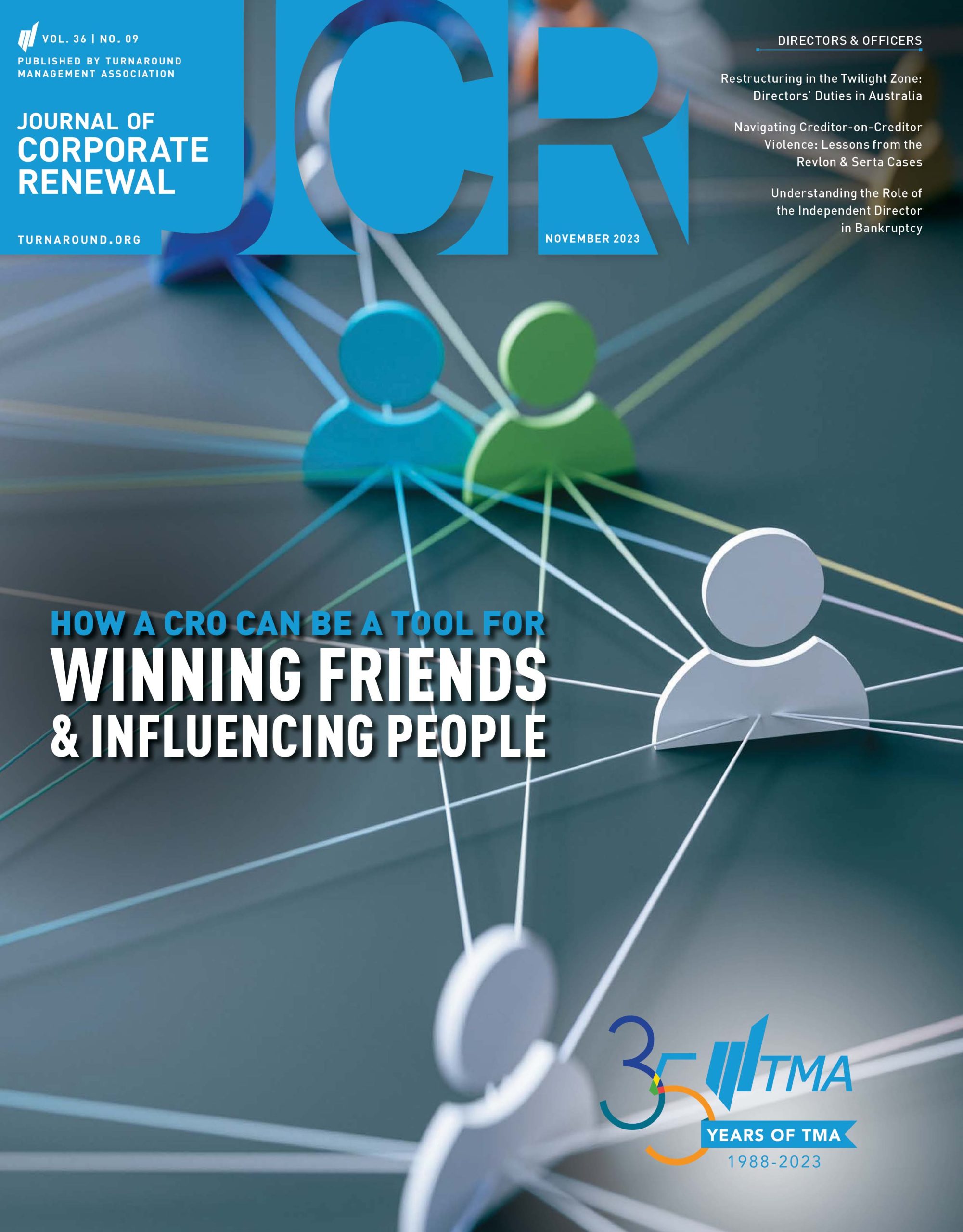November 2023
Feature Article
-

How a CRO Can Be a Tool for Winning Friends & Influencing People
Distressed situations are disruptive. Not only is the company facing financial difficulties—such as declining cash flows and other financial performance metrics, along with potential defaults under debt documents—stakeholders often have lost faith in the current management’s ability to navigate the distress and correct the company’s course. It is within these distressed workout situations that chief […]
More from this Issue
-

Directors & Officers: Risk and Responsibilities When Acting for a Troubled Company
Engaged, experienced management and board members can make a world of difference when implementing a turnaround or maximizing value for stakeholders. Where directors and officers are not familiar with restructurings or lack an understanding of their roles and personal responsibilities, both the board and management will lean heavily on restructuring professionals to not only protect […] -

Better Together at The TMA Annual
A great organization distinguishes itself by how it supports its members and creates value for them, always with an eye toward doing it better. And a few weeks ago in San Francisco, at the TMA Annual 35th Anniversary Gala Conference, that is exactly what we did. This special opportunity broke new ground, celebrated luminaries of […] -

TMA’s Chapter Presidents’ Council: Building—and Strengthening—Bridges
The Chapter Presidents’ Council is a crucial support in the overall structure of TMA as a global organization. The CPC counts among its members the president of each of TMA’s 58 worldwide chapters and is an interconnected network that helps resources flow between TMA Global and membership. Led this year by Chair Rob Patrick […] -

How a CRO Can Be a Tool for Winning Friends & Influencing People
Distressed situations are disruptive. Not only is the company facing financial difficulties—such as declining cash flows and other financial performance metrics, along with potential defaults under debt documents—stakeholders often have lost faith in the current management’s ability to navigate the distress and correct the company’s course. It is within these distressed workout situations that chief […] -

Restructuring in the Twilight Zone: Directors’ Duties in Australia
Australian governance imposes three sources of duties on directors—the Corporations Act, other statutory and common law, and equitable duties based. Anglo-Australasian jurisprudence and statutes have developed a series of good faith, skill, and diligence duties that directors must satisfy in making decisions. Additionally, directors must not engage in self-profit or conflict decisions without disclosure and, […] -

Navigating Creditor-on-Creditor Violence: Lessons from the Revlon & Serta Cases
Distressed companies must often look for creative ways to raise capital. In recent years, so-called “liability management” or “position enhancing” transactions have gained popularity. In those deals, distressed borrowers typically enlist a majority of existing lenders to amend or work around their secured-debt documents so they can raise new capital. The lenders who team up […] -

Understanding the Role of the Independent Director in Bankruptcy
In recent years, more and more distressed companies have appointed independent directors onto their boards to support the restructuring process, from the initial contingency planning through to plan confirmation and emergence from Chapter 11. Consequently, because it is now more likely that professionals in the turnaround industry will be working with independent directors or may […] -

In the Vicinity of Insolvency: Canadian Director Considerations
When a Canadian corporation nears the vicinity of insolvency, which has been described by the Supreme Court of Canada as a deterioration in the corporation’s financial stability, directors or de facto directors should be asking: What is the potential scope of liability? Has it or my duties changed due to the company’s distress? The scope […]
